An aspect of the national conversation on racial inequality that deserves more attention: representation.
African-Americans in the Deep South have long been underrepresented in Congress, even though it's possible to draw more opportunity districts in AL, GA, LA, SC, etc.
African-Americans in the Deep South have long been underrepresented in Congress, even though it's possible to draw more opportunity districts in AL, GA, LA, SC, etc.
For example: 27% of AL's population is black. But right now, black voters are packed into just one of AL's 7 districts (#AL07 on left).
Even though AL is losing a seat in 2022, it would still be fairly easy to draw two black opportunity districts (purple and green on right).

Even though AL is losing a seat in 2022, it would still be fairly easy to draw two black opportunity districts (purple and green on right).


The current AL map was drawn *before* VRA Section 5 was gutted. But even afterwards, groups have successfully sued against similar over-packing in VA, FL & NC among others.
Will the same standard ever be applied in the Deep South? This is a central question for 2021 & beyond.
Will the same standard ever be applied in the Deep South? This is a central question for 2021 & beyond.
• • •
Missing some Tweet in this thread? You can try to
force a refresh







